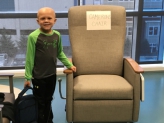Functional Characterization of RELA Fusion Ependymoma as a Basis for Therapeutic Targeting

Ependymoma is a lethal pediatric brain tumor that is still treated by surgery and radiation. When tumors recur, which is often, patients have limited treatment options and often receive additional radiation further worsening neurologic side effects. Novel, effective and less-toxic therapies are desperately needed for these patients. Ependymomas that arise in the forebrain are frequently driven by an oncogene that joins two proteins, C11ORF95 and RELA (denoted as C11ORF95-RELA fusion). When introduced in murine models, C11ORF95-RELA fusion is sufficient to induce tumors that resemble ependymoma, thus implicating this fusion protein as a key contributor of the disease. However, the mechanism by which C11ORF95-RELA protein functions is unknown. Whether C11ORF95-RELA can be inhibited by drug compounds has not been studied.
Project Goal: Our proposal aims to delineate the function of C11ORF95-RELA using a variety of genetic technologies and bioinformatic approaches. Further, we have developed novel murine models driven by C11ORF95-RELA for studying the biology of this fusion protein. Our ultimate goal is to learn more about the mechanisms of C11ORF95-RELA in cancer and uncover drug compounds that can destroy C11ORF95-RELA tumors in murine models. This model-preclinical data is needed for our efforts to advance effective drugs into clinical trials for patients with C11ORF95-RELA ependymoma.
Project Update 2024: Treatment for the third most common childhood brain cancer, ependymoma, has not changed in 30 years. There are no targeted therapies available to children or adults. Our ALSF ‘A’ Award has enabled discovery of mechanisms that regulate a potent driver of ependymoma called ZFTA-RELA. This has led to two promising therapeutic approaches that could be immediately transitioned to clinical trials for patients.

